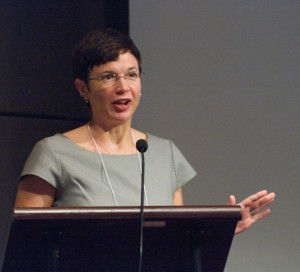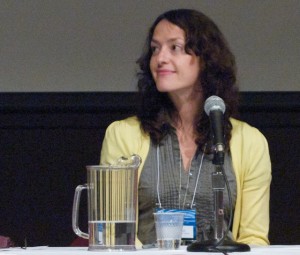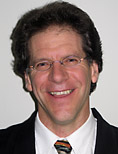July 9, 9:30 AM – Fletcher Challenge Room 1900
Presenters:
Marta Brunner, Librarian for English and American Literature and Comparative Literature at the Charles E. Young Research Library at UCLA
Shana Kimball, Publications Manager in the Scholarly Publishing Office (SPO) at the University of Michigan Library
Archived Video Stream of Session
Background
This session provided the library perspective as a follow up to the previous discussion on the Open Humanities Press (OHP) and its involvement with digital monographs, or “liquid books” (Hall). UCLA is working in partnership with the Open Humanities Press to fulfil a number of open access ideals, while the University of Michigan Library is working specifically to produce and distribute many of the works housed by the OHP online.
Session Overview

Marta Brunner began the second half of the Open Humanities session by explaining her involvement with the online press. Originally she blogged the OHP and its endeavours prior to being contacted by one its founders, Sigi Jöttkandt, to be part of the body’s steering committee. Brunner has used her association with the OHP to bridge the dichotomous divide between research and library domains, which UCLA library has found to be an enormous asset.
“What future is UCLA library working to achieve?” Brunner asserted that this overarching question is the underlying motivation for the university’s work with the OHP. Furthermore, in light of the financial crisis and reduced budgets, open access issues are at a “watershed moment” where scholars and librarians will be working together to make more research freely available online. Brunner then outlined the library’s six fold vision, which ranges in order from most to least achievable:
1. UCLA seeks to be a flourishing hub of institutional repositories. While this is gaining ground many professors are still distrustful of online sources and perceive them to lack the same credibility as their print counterparts.
2. The library envisions itself as a curator of scholarly records. While this is considered a mandate for most university libraries, the “costs of migration” mean that “much content is overlooked” (Brunner).
3. UCLA hopes to disseminate an increasing amount of new digital media, which “enables semantically enhanced” (Brunner) products. The library has not been able to fulfil this goal on a large scale, but has created digital maps through the Hypercities project.
4. The library anticipates playing a greater role in providing open access content in classrooms. The UCLA library uses “a more liberal policy” (Brunner) towards content, which aligns neatly with the ideals of the OHP. One of the main benefits of this institutional leniency will be the increasing availability of cheaper text books spawned from more widely recognised open access scholarship.
5. The UCLA library hopes to be a paragon of a sustainable business model for housing and distributing open access content. Brunner used the comparison of the cost of a Toyota Corolla and the journal “Applied Polymer Science”: The periodical costs considerably more. Consequently, libraries will be facing economic crises as budgets are cut and journal costs stay high.
6. The most difficult goal to attain will be reducing to restrictive nature of academic tenure on open access scholarship. The generally perceived lack of authority of online sources continues to hinder the open access movement.

Shana Kimball began by posing a different question: “How do we scale a liquid book?” The University of Michigan Scholarly Publishing Office (SPO) seeks to provide an answer for this important query. Kimball outlined the role of the publishing branch of the library bOpen Humanities Press Panelefore explaining its core principles. The speaker then elaborated upon how these values guide the publisher’s work towards making research publications more cost effective, as well as elucidating on its partnership with the Open Humanities Press.
The University of Michigan publishing branch currently supports forty predominantly open access online journals, as well as a few print publications. The organisation also runs a “robust” reprint service for its online repositories and has published over 9000 titles on Amazon. Additionally, the SPO is working with the OHP to develop its online monograph (single subject books) endeavour as part of a pilot project whereby the university will “convert, host, provide access to, and archive” the series.
The University of Michigan Scholarly Publishing Office also operates with a set of six main beliefs to guide its aim of making scholarly publishing “more sustainable and scalable” (Kimball):
1. The SPO works at the peripheries of mainstream library services by providing copyright counsel in the copyright arena, cataloguing metadata, maintaining digital library functions and financing complicated transactions.
2. The SPO forms partnerships with other organisations to provide supplementary services, such as content sharing or publication conversions into digital forms amongst other enterprises.
3. The SPO believes strongly in protecting the rights of authors to use their own material as they see fit.
4. The SPO takes small, calculated risks that focus on perpetuating and promoting experimental texts, such as producing scholarly works within Comment Press that can be freely annotated.
5. The SPO provides a myriad of services that range from electronic publication to print on demand to content preservation.
6. The SPO is working cooperatively with the Open Humanities Press to extend its number of published series, as well as further enhance its reputation for high quality academic work. Authors will be able to choose to use a creative commons license while retaining copyright protection.
Ultimately, the SPO cannot attain the goal of supporting the OHP without creating partnerships with other bodies. Furthermore, the task of producing single monograph publications is a daunting one because the library / publisher relationship has been traditionally weak. Kimball concluded her presentation by welcoming interested parties to inquire about future collaborative endeavours and reaffirmed her organisation’s commitment to building the reputation of open access content, as well as being an agent of change in the advancement of the Open Humanities Press’ ideals.
Analysis
Both the UCLA Library and the University of Michigan Scholarly Publishing Office acknowledge to importance of the Open Humanities Press and seek to propagate its principles to the wider academic community. However, achieving change and gaining acknowledgment is proving to be difficult due to general academic distrust, high operational costs, a system of reputation based incentives that favour established scholars, as well as an overwhelming amount of content through which to sort. The goals of the OHP are laudable, but there needs to be an economic compromise between open dissemination of information at no cost to the consumer and providing profitable rewards to creators, researchers or artists in order to perpetuate the transmission of knowledge. The University of Michigan SPO appears to be negotiating this difficult dialectic by working with open access supporters, while charging for unique services and publishing traditional print journals, which is referred to as the mixed approach (Schmidt et al., 2005). The UCLA library, on the other hand, is focussing on reducing costs by embracing predominantly open access works. It will be interesting to see which institution offers the more sustainable business model and if other libraries will adopt these new paradigms. Moreover, it illustrates that the new open access ethos is having to coexist with traditional print resources until an alternative, yet effective, system of rewards can be established.
Related Links
University of Michigan Scholarly Publishing Office
References
Albert, K. M. (2006). Open access: implications for scholarly publishing and medical libraries. J Med Libr Assoc, 94 (3), Retrieved July 9, 2009, from http://www.pubmedcentral.nih.gov/picrender.fcgi?artid=1525322&blobtype=pdf
Antelman, K. (2004). Do open-access articles have a greater research impact?. College & Research Libraries, September, Retrieved July 9, 2009, from http://www.ala.org/ala/mgrps/divs/acrl/publications/crljournal/2004/sep/antelman.pdf
Schmidt, K. D., Sennyey, P., & Carstens, T. V. (2005). New roles for a changing environment: Implications of open access for libraries. College & Research Libraries, September, Retrieved July 9, 2009, from http://paws.wcu.edu/kschmidt/publications/CandRL.pdf


